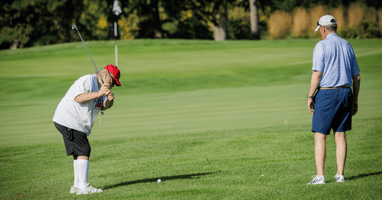No job too small - or big - for CDGA "super" volunteer This article appeared in the November 2024...
August 2024 - Below Ground Level
Rule 16.3 outlines the course of action if you encounter an embedded ball
This article appeared in the August 2024 edition of Chicago District Golfer.
To read more Chicago District Golfer stories, head to our article archive.

You’re walking up to your ball, slightly in the rough and it looks a little odd. It’s sitting down. Is it embedded? How can I tell? Do I get free relief even if I’m in the rough?
As with many questions about the Rules of Golf, let’s start with the definition of an Embedded Ball. According to The Rules, a ball is embedded “When a player’s ball is in its own pitch-mark, in the General Area, made as a result of the player’s previous stroke and where part of the ball is below the level of the ground.”
Seems simple to understand. I’d like to emphasize that the ball must be in its own pitch mark and is the result of the previous stroke. These are two important elements in this definition.
If the player’s ball is in the rough, how do they know if part of the ball is below the level of the ground and not just nestled in the grass? The definition goes on to say, “A ball does not necessarily have to touch soil to be embedded (for example, grass and loose impediments may be between the ball and the soil).” But for the ball to be embedded, a part of the ball must be below the surface of the ground, even if resting on grass.
A player is allowed to check and see if that is the case. Mark the ball and lift it, then determine if the ground has been broken by the ball. I do this by probing where the ball was with my fingers to feel if the ground has been broken. Remember you are not allowed to clean the ball while you are checking. If the ball has not broken the ground, simply replace it and play on.

If the ball has broken the ground, Rule 16.3a(1) says that free relief is allowed if the ball is in the General Area, which includes all of the course except Bunkers, Penalty Areas, and the Green and Teeing Area of the hole being played. So yes, the player gets free relief for a ball embedded in the rough.
Relief is a simple process most of the time. The reference point is directly behind the ball and must be in the General Area. The player must drop a ball within one club length of the reference point, no closer to the hole. Once the ball comes to rest within the relief area the procedure is complete, and the player may continue.
There are a couple of rare situations pertaining to free relief that deserve mention. First, what if the area directly behind the ball is not in the General Area? It might be directly over a bunker or in front of a line defining a penalty area or out of bounds. As outlined in Clarification 16.3b/1, the Rules now allow you to find the nearest spot in the General Area and use that as a reference point.
The second case is if the ball will not come to rest in the relief area; for example, if the relief area is on a steep bank. If the player drops a ball twice and the ball rolls out of the relief area each time, the ball must then be placed where it first touched the ground in the relief area. If after two attempts the ball will not come to rest on that spot, the player needs to follow the procedure defined by Rule 14.2e, which tells us what to do if a replaced ball does not stay on its original spot.
Now, let’s discuss some unique situations I’ve heard golfers ask about.
Is my ball embedded if another player stepped on my ball or drove their cart over my ball? No, those are not the result of the previous stroke and therefore are not embedded balls.
Is my ball embedded if I hit the ball directly into the ground without it getting airborne? No, according to Rule 16.3a(2) the ball must be airborne, so there would be no Embedded Ball relief for a ball in that situation.
What if my ball is embedded in a waste area? It depends – the exception to Rule 16.3a(1) tells us that “relief is allowed only if the ball is embedded in the sand in an area cut to fairway height or less”.
In summary, if you think your ball is embedded after a stroke, make sure that the ball is in the General Area, is in its own pitch-mark and that it has broken the surface of the ground. Then, take proper relief and play on. l
Joe Salierno is a member of the CDGA Championship Rovers Committee. He has been a CDGA Blue Coat since 2013.




.png?height=200&name=Untitled%20design%20(10).png)